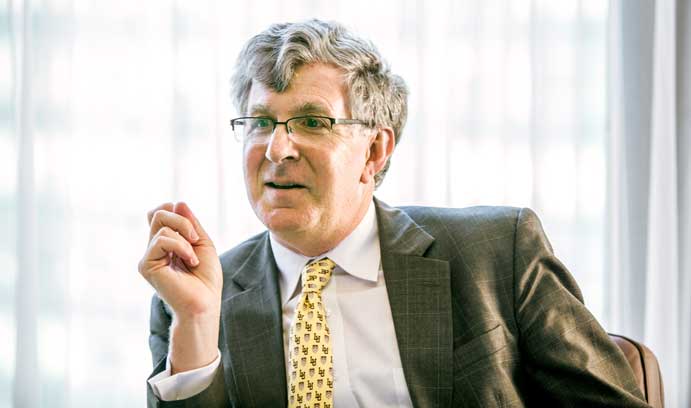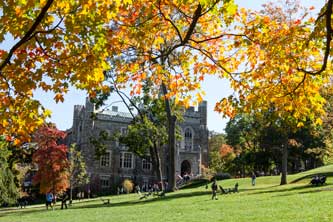Getting to Know John D. Simon: A Q&A with Lehigh’s 14th President

"The people I met at Lehigh were passionate about the university. They care deeply about this institution, and have high expectations and high aspirations for it. It felt like a place I wanted to be, with people I would enjoy working alongside."
Upon the news of his appointment as Lehigh’s 14th president, John D. Simon answered a few questions about what drew him to Lehigh, his vision for the future of the university and his past experiences as a professor, researcher and administrator in higher education.
Simon, executive vice president and provost at the University of Virginia, will take office at Lehigh on July 1, 2015.
What was it that attracted you to Lehigh?
I knew of Lehigh by reputation, of course. As I began to learn more about the university, I was impressed by the interdisciplinary work happening here, and by the number and quality of integrated programs. In today’s world, collaboration is paramount, and it is one of Lehigh’s great strengths.
Then there was deeply ingrained practical application of knowledge, which is a hallmark of Lehigh, and something many other universities are trying to do, most often not nearly as well.
I am a teacher at heart, and Lehigh’s focus on students was apparent to me as I learned more about the university. The quality of the faculty and the breadth of the work being done are impressive. The commitment of the staff is apparent.
Ultimately, a decision like this comes down to people. The people I met at Lehigh were passionate about the university. They care deeply about this institution, and have high expectations and high aspirations for it. It felt like a place I wanted to be, with people I would enjoy working alongside.
What opportunities do you see at Lehigh?
Already, a couple areas of strength stand out to me. First, it’s clear how much those who make up this university community—students, faculty and staff and its many alumni and friends—love Lehigh. So I believe very strongly that we can capitalize on the passion they have for this university to continue the proud Lehigh tradition of graduating young people who are ready to make a difference in the world around them.
I also see a great opportunity for Lehigh to deepen and strengthen not only the connections between its four colleges, but also between the physical spaces of its campuses. For example, I would be interested in undertaking efforts to create more seamless connections between the research and education happening every day on the Asa Packer Campus with those same activities happening on the Mountaintop campus. The initiative at Mountaintop speaks directly to Lehigh’s willingness to forge new paths, to take risks and to seek new ways of teaching and learning. But this great experiment can only grow stronger if we can connect the intellectual breakthroughs it creates with those that are fostered on our Asa Packer Campus as well.
You’ve worked at several very different institutions. What experiences and people have shaped you over the course of your career?
I have been fortunate in my career to work at some truly great universities, and have also had the pleasure of working alongside many bright, inquisitive and ambitious individuals—people who have impacted the way I’ve approached my teaching, research and leadership.
In that regard, it’s very difficult for me to point to only a few. But I would say that there are four people who stand out as perhaps my most treasured mentors. Mostafa El-Sayed, my research director during my time as a post-doctoral fellow at UCLA, has been a life-long friend and taught me what it really meant to be a scientist. Paul Saltman, a fellow faculty member and friend at the UCSD, taught me that being at a university brought with it the responsibility to serve the surrounding community. Peter Lange, the provost I served under at Duke, taught me how to be a patient and focused administrator. And Teresa Sullivan, president of the University of Virginia, has in so many ways taught me that university administrators must place the needs of their institution above their own. I am grateful to them all.
What are some of the biggest challenges you see, both for higher education in general and for Lehigh specifically?
We find ourselves living through a challenging time in higher education. There is increased scrutiny by the public about the value of what we do, and that scrutiny has contributed to both unstable federal support and increased efforts to establish mechanisms of accountability. At the same time, we are seeing a rapid globalization of research and education that challenges our nation’s status as the established leader in higher education.
The list only continues from there. We are seeing keener competition for faculty, students, and financial resources; changing definitions and methods of teaching and learning; fast-shifting patterns in research funding; heightened expectations by both undergraduate and professional students and their families for personal services and co-curricular programs; and the obvious tension between online and residential experiences, just to name a few. At the same time, we see institutions of all kinds struggling with the question of how they can best leverage the inherent power and value of diversity in creating transformative learning environments.
These are big challenges, but I believe Lehigh is well positioned to navigate them, and by doing so can make major contributions to defining the best in higher education for the coming decades.
Lehigh has undertaken efforts in recent years to create a more diverse and inclusive learning environment. What do you see as both the inherent challenges of creating these kinds of environments and the long-term benefits that they offer for institutions of higher learning?
I have found at other universities, embracing diversity in all forms—from race and ethnicity, to faith, to socio-economic status, to issues of gender or sexual orientation, to cultural differences—is a means for achieving excellence. Building diverse communities of students, faculty, and staff is essential to realizing our aspired excellence in teaching, research, and service. Achieving diversity and inclusion is an ever-evolving challenge requiring ongoing commitment and attention; only by assuring that we create an environment where everyone feels welcome, respected and listened to can individuals and the institution as a whole reach their highest potential.
Diminished funding for research remains a concern. What do you see as the impact on universities and on society?
This is a really important question for all institutions of higher learning. For places like Lehigh and many others, I think it means that you need to think about diversifying the research portfolio that you hold. It also means trying to deepen the partnerships you have with industry. I believe that Lehigh is well positioned to do both of these things.
My greater concern is that the research funding challenges will translate into fewer students choosing research careers. This would significantly impact the number of candidates for the faculty of the future as well as the ability to meet the demands for creative researchers by industry and government labs.
What advice do you offer first-year students?
Well, being in some ways a prospective first-year at Lehigh myself next year, this is an interesting question for me to answer. I would encourage our first-years to keep an open mind about what’s important, and to experience all that this great university has to offer. I would tell them to feel free to follow their passions and to take risks. Just as importantly, and in the tradition of Lehigh’s great success at educating leaders, I would push them to never shy away from a leadership opportunity. I would also say that they should open themselves up to opportunities to spend meaningful time with people different than themselves—to embrace the opportunity to learn from and work with people who come from different backgrounds.
Posted on:


